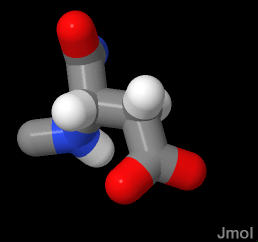
Unprotonated (base form - negative)
dominant form at physiological pH



Aspartic acid ends in an organic acid which ionizable (can lose a proton to solvent and becomes negatively charged)
At physiological pH of 7 the the terminal acid in aparatate is generally unprotonated (in the base form and negatively charged) it is frequently exposed to water as it is in the demonstration below. In this case, the aspartate is found in random coil.
  Atom Label Description | |
|
Click an atom to diplay it's identity here | |
|
Messages about the currently highlighted features |